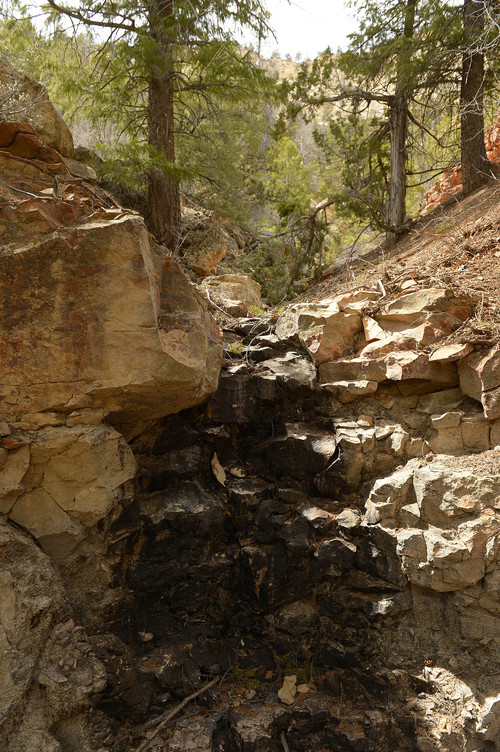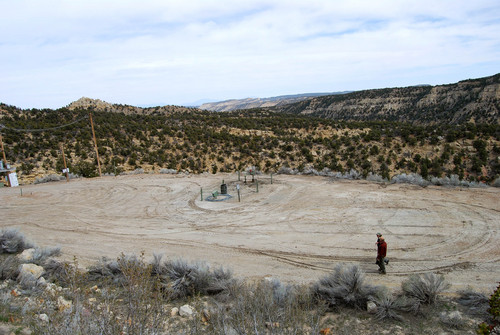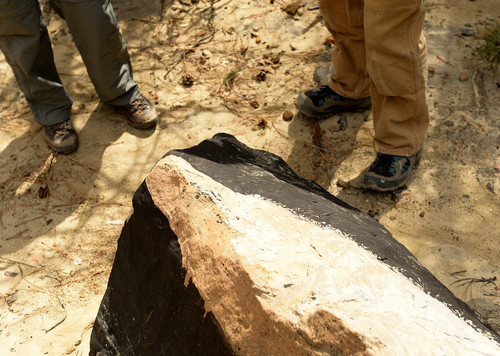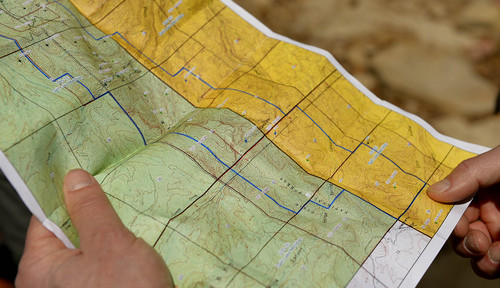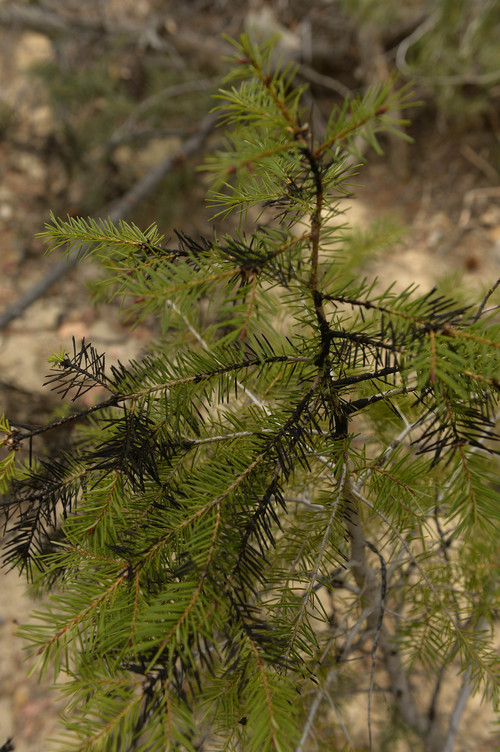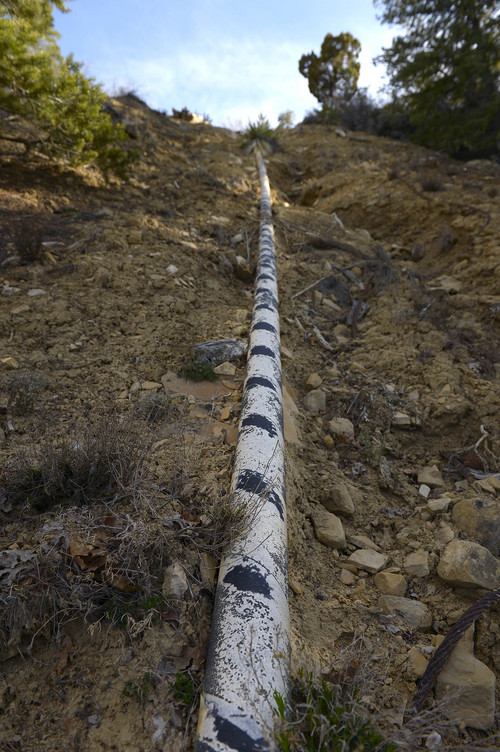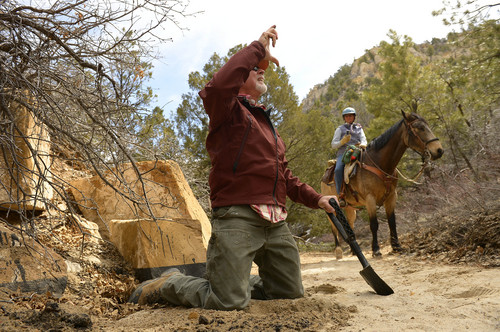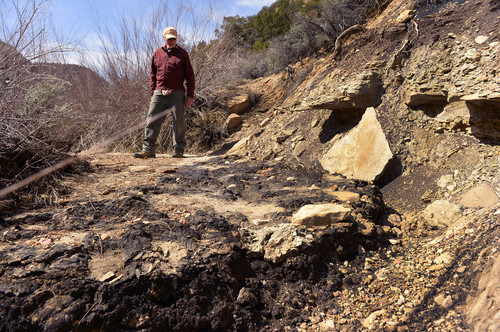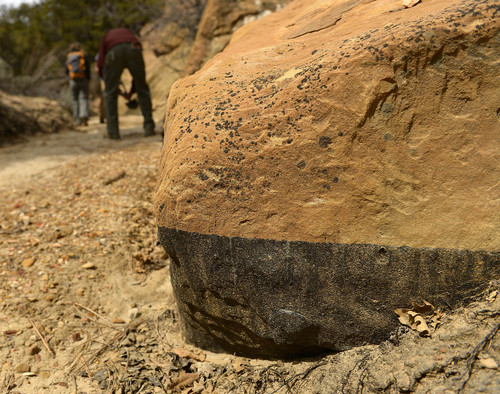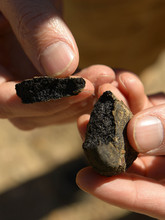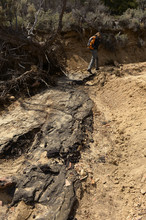This is an archived article that was published on sltrib.com in 2014, and information in the article may be outdated. It is provided only for personal research purposes and may not be reprinted.
Escalante • The oil caking a desert wash in the Grand Staircase-Escalante National Monument first cascaded down a steep gully, seeming to originate from under a spur road serving an outlying well in the old Upper Valley oil field.
Clambering up the gully Saturday, local outfitter Nate Waggoner tried to reconstruct how the liquid moved. He noted the telltale stains left as the oil poured over sandstone blocks and logs before hitting Little Valley Wash. The spill now smothers a 1.5-mile stretch of the wash's sandy bed under a crumbly, squishy carpet of tar six inches deep.
Sharp black horizontal lines on the rock walls disclose just how high the oil slick rose in flat sections of the wash — which one resident dubbed "the Little Valdez," in reference to the spill that fouled Alaska's Prince William Sound 25 years ago this month.
Hikers discovered this mess March 22 and there is no question it came from the oil field straddling the Dixie National Forest boundary line. A critical question raised by the field's operator, Citation Oil and Gas Corp., however, is when did the oil get in the wash, about 400 vertical feet below its southern-most well, known as Upper Valley No. 27.
After a preliminary inspection last week, the Bureau of Land Management postulated that the oil spilled 40 years ago and was exposed in a flash flood last September. That would date the release to an era when environmental standards were lax, and long before Citation took over the Upper Valley field from Tenneco, which developed these wells a half-century ago on a rugged plateau a dozen miles west of Escalante.
Jana Richman isn't buying it. The blackened branches of young tress and other evidence in the wash point to a more recent origin for the spill. She noted flash floods, like the rippers of October 2006, strike this region regularly, yet none disturbed this hydrocarbon tar bomb supposedly lurking for decades in Little Valley Wash.
"By their own logic, the 2006 floods should have brought it down," said Richman during an inspection of the oil damage with journalists, her husband and other Escalante residents mounted on horses including Waggoner. "It bothers me they come up with an answer quickly to satisfy everyone so we go away."
Citation officials did not respond to messages left at the company's local and regional offices and Houston headquarters. But BLM officials say the company acted responsibly since learning of the spill Monday. Citation shut down the well, and cooperated with BLM and the Forest Service's on-the-ground investigation, according to BLM spokeswoman Megan Crandall.
BLM's old-oil scenario appears to exculpate Citation, but it hardly explains what caused the spill or how hundreds of barrels of errant oil went unnoticed for more than four decades.
Meanwhile, the company has had problems with unreported leaks from its aging network of gathering lines in the recent past, according to the Dixie National Forest, which administers most of the oil field.
Even if Citation did not spill the oil, it owns the mess and will likely be responsible for repairing the damage.
The key question though is not how to remove the oil, but whether that's even a good idea. BLM officials say removing it may do more harm. So the spill could wind up being a petrochemical gift that keeps giving for years, shedding bits of tar every time the wash floods and dispatching hydrocarbons toward one of the West's most revered free-flowing rivers.
Upper Valley lies at the headwaters of the Escalante, a watershed that is the subject of a huge conservation investment to restore native vegetation and fish that have been long displaced by introduced species.
This river and its tributaries carved the canyons that are among the most striking features of the national monument. Established in 1996, the Staircase is the crown jewel of the BLM's 27-million-acre National Landscape Conservation System. The system's director Carl Rountree called the spill "a wake-up call."
"We have to recognize where there is old infrastructure in place we want to more carefully look at what can happen," Rountree said. "We need to be more vigilant. I imagine our folks will be spending more time looking at this event and finding what the future prospects of future events are."
The conservation community pointed to the spill as evidence supporting leasing reforms geared toward directing future oil and gas development away from parks and other sensitive areas.
"Someone should have been out there monitoring what's going on," said Phil Hanceford, of The Wilderness Society.
Little Valley Wash cuts though the yellow sandstone and mudstone that characterizes the Kaiparowits Formation, deposited during the twilight of the dinosaurs' reign and famous for its vast coal deposits and fossil discoveries.
The wash is easily accessible off the Smokey Mountain Road that runs south of town. At its confluence with Alvey Wash, four miles downstream from the spill site, oil damage is apparent. Black goo clings to vegetation growing in the bed. Rocks are spattered with black stains. Disc-shaped tar blobs the size of half-dollars litter the bed. The damage gets worse as the wash winds up through pinyon-juniper and ponderosa forests, until after 2.5 miles where oil deposition forms a nearly unbroken ribbon of asphalt in the stream channel.
Steve Defa, Richman's husband, paused over a spot where the glop backed up behind a rock.
"Would oil that was 40 years old still look like this?" Defa posed, plunging his fingers into the wash bed and pulled out a viscous plug. He rubbed it around his fingers, which quickly smeared with brown lubricant.
"That's some good oil."


